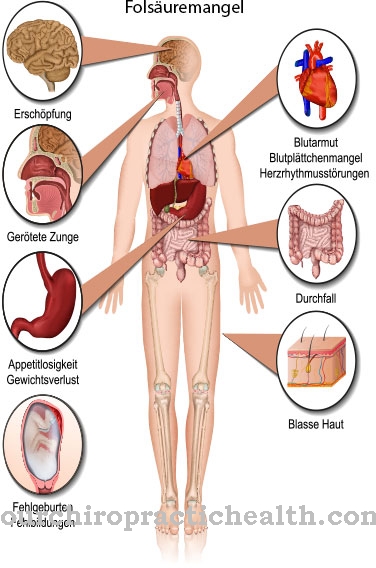With Neutrophilia refers to a number of neutrophils (neutrophils) in the blood that exceeds the normal level. Neutrophilia is one of several possible forms of leukocytosis, which is a common term used to describe an increase in the number of white blood cells, including neutrophils. There are many endogenous and exogenous factors, including immune responses, that cause a temporary or permanent neutrophil excess.
What is Neutrophilia?

© feirin - stock.adobe.com
For neutrophils, which are part of the innate immune system, the abbreviation Neutrophils used. They are a specific form of white blood cells (leukocytes) and make up the largest proportion of all leukocytes. A temporary or permanent increase in the number of neutrophils in the blood above normal is known as neutrophilia.
Neutrophilia is therefore a special form of leukocytosis, which is generally used to describe an increase in the number of leukocytes. The neutrophil granulocytes belong to the unspecific innate immune defense. They are permanently "on patrol" in the blood and in an inactive form also as "posts" in the tissue. A rapid and short-term increase in their number in the blood may be an immune reaction or indicate disease of the neutrophils themselves.
The majority of neutrophils are so-called segmented, differentiated neutrophils, of which 3,000 to 5,800 per microliter normally circulate in the blood. Rod-core neutrophils, which are not yet fully differentiated, normally appear with a number of around 150 to 400 per microliter of blood.
causes
Neutrophilia can be caused by many endogenous and exogenous factors and triggers. In most cases of a temporary increase in neutrophil granulocytes, only endogenous causes such as the release of stress hormones - especially adrenaline - play the greatest role.
In external circumstances that cause acute stress with a sudden increase in the adrenaline level, the body is prepared for brief muscular and mental peak performance for flight or attack. This also includes taking precautions so that in the event of injuries as little blood as possible is lost by narrowing the peripheral blood vessels and being able to react more quickly to germs that use possible external injuries as entry points.
As a precautionary measure, the immune system induces temporary neutrophilia, which subsides after about an hour. The immune system is also the trigger of neutrophilia in acute inflammation, severe injuries, operations and infections as well as in an increase in the level of glucocorticoids. The drastic increase in the number of neutrophils is usually associated with a so-called shift to the left.
An increasing number of not yet fully developed rod-shaped neutrophils are channeled from the bone marrow into the bloodstream.A similar process as a response of the immune system occurs in chronic inflammation and in some types of neoplasia (cancer). A particularly severe form of neutrophilia occurs in chronic granulocytic leukemia such as myeloid leukemia, in which, if left untreated, genetic factors lead to an unchecked proliferation of leukocyte precursor cells.
Symptoms, ailments & signs
An increase in neutrophil granulocytes above the normal level is usually completely asymptomatic. Symptoms only occur in connection with the factors triggering neutrophilia. For example, inflammation or injury can cause pain, but this cannot be attributed to the neutrophilia that then develops.
Complaints and signs that can be associated with the multitude of other causes are neither caused nor aggravated by the pathologically increased number of neutrophils.
Diagnosis & course of disease
Since neutrophilia is completely symptom-free, it is mostly discovered more or less by chance in the course of laboratory blood tests. The routine determination of blood values in the laboratory allows differentiation between the various leukocytes. A distinction is made between neutrophils, lymphocytes, monocytes, eosinophils and basophils, which perform different tasks within the immune system.
The course of neutrophilia depends very much on the course of the causative factors. It can be self-regulating, as in the case of a stressful situation, or it can also resolve itself again after overcoming a local or systemic infection, or in the case of myeloid leukemia - if left untreated - it can take a serious course.
Complications
In most cases, there are no particular symptoms or complications with neutrophilia. However, in some cases, neutrophilia can lead to inflammation and infection more quickly. The symptoms are very different, so that in most cases neutrophilia is diagnosed relatively late. However, neutrophilia does not have any negative health effects on the person's body.
In many cases, the complaint disappears completely when the infection or inflammation is over. Special treatment is not necessary. However, neutrophilia can also occur as a result of leukemia and have a negative effect on quality of life. In this case, it is possible to treat neutrophilia with the help of drugs.
However, there are no complications here either. The life expectancy of the patient is also not affected by neutrophilia. As a rule, this disease cannot be prevented. However, hygiene measures must be taken, especially after surgery, in order to avoid infections and inflammation.
When should you go to the doctor?
Usually a rapid and short-term increase in the leukocytes in the blood indicates an immune reaction in the body or the release of the stress hormone adrenaline, which initially does not require medical treatment as the value levels off by itself.
However, if neither an injury, an acute inflammation or an infection is the trigger for an increase in the white blood cell count, neutrophilia cannot be ruled out. Since neutrophilia itself does not reveal any symptoms, it is usually only detected in the blood count due to other symptoms.
A visit to the doctor should therefore always be advisable if the patient feels uncomfortable, tired or listless for a long period of time without any recognizable signs of illness. Since in most cases major injuries or infections drive those affected to the doctor, the disease is usually diagnosed by taking a blood sample. In rare cases, neutrophilia is also associated with leukemia. Here, the leukocytes themselves are the primary factor responsible for the disease based on genetic bone marrow changes, which requires treatment to be started immediately.
Treatment & Therapy
The treatment of neutrophilia always depends on the treatment of the underlying primary disease or on the removal of possible exogenous factors. These include, for example, the administration of certain medications or a change in lifestyle, for example if smoking is a main cause of neutrophilia.
As a rule, after successful treatment of the underlying disease, the number of neutrophils and the other leukocytes levels off again in the normal range. This means that by eliminating the triggering factors, it is left to the immune system to restore normal conditions. A treatment that aims directly at reducing neutrophils without taking into account the causative factors does not exist and would also not make sense.
The situation is different only in the case of acute myeloid leukemia. In the disease caused by genetic changes in the bone marrow, the extraordinary proliferation of the leukocytes themselves is the primary disease. Possible forms of therapy therefore aim directly at reducing uncontrolled proliferation.
Outlook & forecast
The prognosis of neutrophilia is often linked to the cause of the disease. If external circumstances are responsible for the impairment to health, the further course of the disease is largely dependent on the person's willingness to change. Persistent stress and states of strong emotional stress lead to the physical irregularities.
Even without medical treatment, the person affected should learn to be able to deal with life developments and everyday challenges in a more relaxed manner. Numerous self-regulation techniques can already help to relieve stress and alleviate symptoms.
In many cases, it is advisable to work with a psychotherapist, as the success of the treatment is significantly improved. Behaviors and cognitive techniques are learned so that a better way of dealing with stressful situations is made possible. Drug treatment is often initiated in the event of a physical irregularity. In these cases the possibilities of self-help are insufficient to achieve lasting improvement. Long-term therapy is required so that the organism is regulated.
In principle, the prognosis improves if the person's lifestyle is optimized. It has been shown that avoiding harmful substances such as nicotine or alcohol can help alleviate the symptoms. In addition, the consumption of medication should only take place in consultation with the treating doctor. Otherwise, side effects may occur that lead to an increase in the symptoms.
prevention
Due to the many possible causes of neutrophilia, direct preventive measures that would prevent the onset of the disease are hardly conceivable. Indirect measures that bring about a strengthening of the immune system basically mean that the immune system can overcome most of the causative factors such as infections, operations and injuries itself and that an interim neutrophilia regresses by itself.
Aftercare
In the case of neutrophilia, the measures and options for follow-up care are in most cases very limited, so that the person affected with this disease is definitely dependent on immediate medical treatment. The earlier the disease is recognized and treated, the better the further course is usually, so that the person affected should consult a doctor at the first symptoms and signs of the disease.
In most cases, self-healing cannot occur, so that a doctor should be consulted at the first signs of the disease. Most people who have neutrophilia are usually dependent on various medications. It is important to ensure that it is taken regularly and that the dosage is correct in order to relieve the symptoms correctly and permanently.
If anything is unclear or if you have any questions, a doctor should be consulted first. During treatment, regular check-ups and examinations by a doctor are usually very important in order to determine further damage to the internal organs. The further course of neutrophilia is, however, highly dependent on the time of diagnosis and also on the severity of the disease, so that a general prediction is not possible.
You can do that yourself
Due to the multitude of possible causes of neutrophilia, the approaches to self-help are less specific than broad. In addition to the specialist treatment of the underlying disease, it is of central importance to support the body in the healing process. Everything that helps to strengthen the immune system also helps to alleviate inflammatory processes in the body.
The immune system can be strengthened in a variety of ways: A balanced diet, which is adapted to the respective age, the energy requirement and the state of health, forms the basis of a balanced lifestyle. Since the body is weakened by the consumption of harmful substances such as nicotine and alcohol, it is important to reduce it or to do without it completely. In addition, stress is a negative factor influencing the immune system. If stress cannot be avoided, it is advisable to integrate a balance of exercise and relaxation into everyday life. Depending on the severity of the clinical picture, there are individual options for implementation in terms of duration and intensity.
Although the clinical picture of neutrophilia appears so heterogeneous, there are indirect ways to support the healing process and alleviate symptoms in everyday life.





.jpg)
.jpg)




















